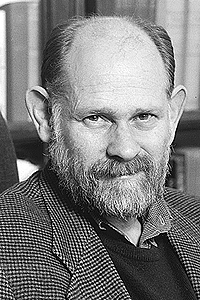Religion historians will explore Zoroastrianism, ancient, Persian religion at May 11 conference
By Josh SchonwaldNews Office
 Bruce Lincoln is the organizer of the conference, Recent Research on Religion in Ancient Iran. | |
According to most estimates, there are fewer than 200,000 adherents of Zoroastrianism in the world today, and yet this minority religion continues to be of great interest to historians of religion.
Most experts consider the oldest Zoroastrian texts to have been composed sometime between 1700 and 1000 B.C., although it is difficult to be certain, explained Bruce Lincoln, the Caroline E. Haskell Professor of the History of Religions in the Divinity School and the organizer of a Divinity School conference on this religion of ancient Iran.
Similar ideas to Zoroastrianism played a powerful role in the Persian empire of Cyrus, Darius and Xerxes, from 550 to 330 B.C., and influenced the development of Judaism, Christianity, Islam, Manichaeanism and other religions, Lincoln said.
“Recent Research on Religion in Ancient Iran” will bring some of the world’s leading experts to Swift Hall Friday, May 11. The conference, which will run from 9 a.m. to noon in the Swift Commons, will feature three papers.
One of the leading translators of early Iranian religious literature, Jean Kellens, professor of Indo-Iranian languages and religions at the Collège de France, will discuss his work when he presents “Liturgy and the Dialectic of Souls.” Examining hymns from the Avesta—a collection of the oldest Zoroastrian sacred texts—Kellens will focus on one of the more unique features of Zoroastrian thought—the soul. “The soul is a very complicated entity,” said Lincoln. “Zoroastrians theorize a great many spiritual components of the person, each one describing a different aspect of the self, and none precisely corresponding to the one rather simple but mysterious entity we call ‘the soul.’”
Another scholar, Clarisse Herrenschmidt of the France’s Centre National de la recherche scientifique, will present a paper that focuses on the Zoroastrianism of Cyrus the Great and Xerxes. In her presentation, titled “Considerations on the Inscriptions of Artaxerxes II,” Herrenschmidt will focus on a watershed religious reform. During the reign of Artaxerxes, from 404 to 358 B.C., two new gods were introduced, Mithra, a god of legal issues, and Anahit‰, a fertility goddess. Herrenschmidt will explore the context and motivation for this choice, Lincoln said. “Why were these new gods added? And what does it reflect of the politics of the time?”
Lincoln also will deliver a paper that focuses on Zoroastrianism under the Sassanian empire (226 to 651 A.D.), which followed the Arab conquest. In “Anomaly, Science, and Religion: Treatment of the Planets in Medieval Zoroastrianism,” Lincoln, who has examined texts in the Middle Persian language Pahlavi, will explore the way the Zoroastrians responded to cosmological questions that stand at the border of science and religion.
“In Europe in the 16th and 17th centuries, information regarding the peculiarities of planetary motion led to Copernicus, Kepler and Galileo to challenge orthodox notions regarding the nature of the cosmos,” Lincoln said. “More than a millennium earlier, the same date stimulated heated discussion in Sassanian Iran. Instead of pitting ‘scientific reason’ against ‘religious faith,’ however, Sassian intellectuals adapted existing beliefs to account for this new information, thereby avoiding a crisis in regard to the very foundation of knowledge.” Lincoln’s paper explores how and why this idea was possible.
Though the conference’s papers are from disparate periods and have widely varying subjects, Lincoln sees a connective theme. “We’re all concerned with the way in which religious sensibilities have influenced other aspects of ancient Iran—whether it’s politics, culture, psychology, astronomy or astrology.”
![[Chronicle]](/images/sidebar_header_oct06.gif)